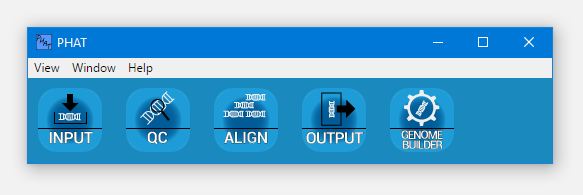For 0.7.13
Projects
PHAT uses the concept of projects to group and maintain sets of input data, results and intermediary files together so they can be saved, copied and shared as one package. To create a new project, upon starting PHAT, click on “New Project” and give it a name. It will be created and opened if you click “OK”.

When you create a project, it is saved in PHAT internally. In order to export your project to share it with others, upon starting PHAT, click “Open Project”, and click “Export” beside the name of the project you want to export.
In order to open a project from a file, instead of one from the list of projects, upon starting PHAT, click “Open Project” and then “Open From File”.
The project named under “Currently Open Project” is the last project that you opened, and the one which is currently unpacked. Opening it will be extremely fast compared to opening a different project. If your project failed to save for some reason or PHAT happened to crash without saving, it will still be intact and openable from here. If you open a project other than the “Currently Open” one, anything which failed to save will be lost.

About Projects
PHAT maintains a single “run time” directory (resources/app/rt/) internally where all intermediary files and results are written to. A manifest file is maintained within (resources/app/rt/rt.json) that describes everything from input files and their locations, to the positions and sizes of various application windows. This folder and its manifest are what make up a PHAT project. Anything written into this directory will be saved along with the rest of the project.
PHAT makes a distinction between “open” and “not open” projects. An “open” project is that which currently resides in resources/app/rt/. “Not open” projects are those which are not currently in resources/app/rt/ and must have their tarballs unpacked into resources/app/rt/ before they can be manipulated.
A project is said to be “not exported” if its tarball is saved to resources/app/projects/ and it has a corresponding entry in resources/app/projectManifests.json. Those projects which are “not exported” will appear in the list of projects in PHAT’s “Select Project” window on startup. A project is said to be “exported” if its tarball is saved to a location other than resources/app/projects/ and it has no entry in resources/app/projectManifests.json.
For projects which are “not exported”, the application.project.isExternal key in its manifest will be set to false and the application.project.externalPath key will be set to "". The save project operation will save projects with application.project.isExternal set to false to resources/app/projects/uuid where uuid is the UUID of the project. For projects which are “exported”, the application.project.isExternal key in its manifest will be set to true and the application.project.externalPath key will be set to an absolute path to the location to save the project tarball on save. The save project operation will save projects with application.project.isExternal set to true to the path defined in application.project.externalPath. In case “exported” projects have been moved in the filesystem since the last time they were opened, the open project operation will patch the project’s application.project.externalPath key with the filepath being loaded from.